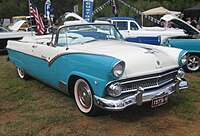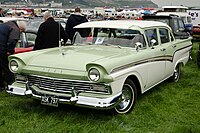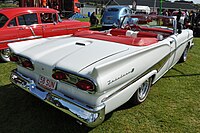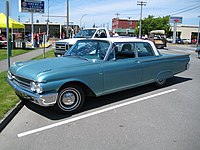Ford Fairlane (Americas)
| Ford Fairlane | |
|---|---|
FR layout | |
| Chronology | |
| Predecessor | Ford Crestline[2] |
| Successor | Ford Galaxie (full-size) Ford Torino (mid-size) |
The Ford Fairlane is an
Initially introduced as the flagship of the full-size Ford range, the Fairlane marked the introduction of the Crown Victoria and 500 nameplates, both later becoming stand-alone full-size model lines (the latter, as the Ford Five Hundred).
Following the introduction of the Ford Galaxie, the Fairlane 500 (and Fairlane) became Ford's base models, equivalent to the Chevrolet Bel Air and Biscayne respectively, until 1962, when it was repackaged as an intermediate-segment car (today, mid-size) from 1962 to 1970. For 1971, Ford expanded the Ford Torino nameplate across its entire intermediate range, dropping the Fairlane (and Falcon) nameplates in North America. In South America, the sixth generation Fairlane was marketed through 1981; Ford Australia used the nameplate on its own version of the Fairlane (a long-wheelbase Ford Falcon) through the 2007 model year.
First generation (1955–1956)
| First generation | |
|---|---|
sedan four-door sedan four-door station wagon | |
| Chassis | body-on-frame |
| Related | Mercury Monterey Ford Mainline Ford Customline Ford Ranch Wagon Ford Country Sedan Ford Country Squire Ford Parklane Ford Courier |
| Powertrain | |
| Engine | 223 cu in (3.7 L) I-Block I6 272 cu in (4.5 L) Y-Block V8 292 cu in (4.8 L) Thunderbird V8 (1956) 312 cu in (5.1 L) Thunderbird V8 (1956) |
| Transmission | 3 speed Fordomatic 3 speed Standard |
| Dimensions | |
| Wheelbase | 115.5 in (2,934 mm) |
| Length | 198.5 in (5,042 mm) |
| Width | 75.9 in (1,928 mm) |
| Height | 61.0 in (1,549 mm) |
For the 1955 model year the Fairlane name replaced the
The Fairlane 4-door Town Sedan was the most popular sedan Ford sold that year, having manufactured 254,437 with a listed retail price of US$1,960 ($22,293 in 2023 dollars [3]).[4]
Few changes were made for 1956; a four-door Victoria hardtop and two new, more powerful V8 options, of 292 cu in (4.8 L) and 312 cu in (5.1 L), the latter available up to 225 bhp (168 kW; 228 PS), were introduced. The Lifeguard safety package was introduced. The two-door Victoria hardtop featured a new and slimmer roofline. A one-year only two-door station wagon, the 1956 Ford Parklane, featured Fairlane-level trim. It was marketed to compete against the Chevrolet Nomad.
-
1955 Ford Fairlane Town Sedan
-
1955 Ford Fairlane Sunliner
-
1955 Ford Fairlane Country Squire station wagon
-
1956 Ford Fairlane Club Sedan
-
1956 Ford Fairlane Victoria coupe interior
Second generation (1957–1959)
| Second generation | |
|---|---|
coupe utility | |
| Chassis | body-on-frame |
| Powertrain | |
| Engine | 223 cu in (3.7 L) Mileage Maker I6 292 cu in (4.8 L) Thunderbird V8 312 cu in (5.1 L) Thunderbird V8 (1957) 332 cu in (5.4 L) Interceptor V8 (1958–1959) 352 cu in (5.8 L) Interceptor V8 (1958–1959) |
| Transmission | 3 speed Cruise-O-Matic (1958–1959) 3 speed Fordomatic (1957–1958) 2 speed Fordomatic (1959) 3 speed Standard |
| Dimensions | |
| Wheelbase | 118 in (2,997 mm) |
| Length | 201.7 in (5,123 mm) |
| Width | 78.2 in (1,986 mm) |
| Height | 58.9 in (1,496 mm) |
For 1957, a new style gave a longer, wider, lower, and sleeker look with low
Another facelift for 1958 had fashionable quad headlights, a grille that matched the 1958
of 332 and 352 CID (5.4 L and 5.8 L) replaced the previous largest V8s, and a better three-speed automatic transmission was also available with a steering column transmission gear selector lever.A new top-level full-sized model was introduced at mid-year 1959, the Ford Galaxie. The 1959 Galaxie displayed both "Fairlane 500" and "Galaxie" badging.
-
1957 Ford Fairlane 500 Town Sedan
-
1957 Ford Fairlane 500 Skyliner interior
-
1958 Ford Fairlane 500 Skyliner showing the top mechanism in action
-
1958 Ford Fairlane 500 Victoria Club Coupe
-
1958 Ford Fairlane Sunliner rear
-
1959 Ford Fairlane 500 Skyliner
-
1959 Skyliner, the Ford Galaxie models displayed both "Fairlane 500" and "Galaxie" badges
Third generation (1960–1961)
| Third generation | |
|---|---|
sedan 4-door sedan | |
| Chassis | body-on-frame |
| Related | Ford Ranch Wagon Ford Country Sedan Mercury Meteor Ford Galaxie |
| Powertrain | |
| Engine | 223 cu in (3.7 L) Mileage Maker I6 292 cu in (4.8 L) Thunderbird V8 352 cu in (5.8 L) Thunderbird V8 390 cu in (6.4 L) Thunderbird V8 (1961) |
| Transmission | 3 speed Cruise-O-Matic 2 speed Fordomatic 3 speed Standard |
| Dimensions | |
| Wheelbase | 119 in (3,023 mm) |
Full-sized Fairlane and Fairlane 500 models were restyled for 1960 and again for the 1961 model year. The Galaxie series continued as the top-of-the-line full-sized Ford. Fairlane 500s demoted to mid-level in the lineup and were equivalent to the Chevrolet Bel Air. Fairlanes were primarily sold as base level trim models for fleet use (taxi, police). Two bodystyles were available, a 2-door pillared sedan (Club Sedan and Business Sedan) and a 4-door pillared sedan (Town Sedan).
While the 1960 de luxe Galaxie and Fairlane 500 series sported a tri-color Ford crest on the hood, base Fairlanes had "FORD" in chrome block letters across their hoods. For 1961, all models got the block letters on their hoods.
The big-block 390 CID V8 was available in 1961 as the top-horsepower option, as the "horsepower wars" in Detroit continued.[6][7]
-
1960 Ford Fairlane Club Sedan rear
-
1960 Ford Fairlane Club Sedan
-
1960 Ford Fairlane 500 Town Sedan
-
1961 Ford Fairlane 500 Club Sedan
Fourth generation (1962–1965)
| Fourth generation | ||
|---|---|---|
Curb weight | 2,930–2,970 lb (1,329–1,347 kg) | |
The Fairlane name was moved to Ford's new intermediate, introduced for the 1962 model year, to bridge the gap between the compact
Like the Falcon, the Fairlane had a unibody frame, but the body incorporated an unusual feature Ford dubbed torque boxes, four boxed structures in the lower body structure designed to absorb road shock by moving slightly in the vertical plane. Suspension was a conventional short-long arm independent arrangement in front, with Hotchkiss drive in the rear. The Fairlane was initially offered only in two-door or four-door sedan body styles.
The Fairlane's standard engine was the 170 CID (2.8 L)
Ford saw the problem and introduced two pillarless hardtop coupes for 1963, in Fairlane 500 and Sports Coupe trim. For 1963 and later Sports Coupe models, the center console, which had come from the Falcon parts bin for 1962, was changed to be similar to that of the Galaxie. Sports Coupe models got a floor-mounted shift lever for the center console when Cruise-O-Matic or 4-speed manual transmissions were specified; however when the two-speed Fordomatic was ordered, the shift lever was installed on the steering column (and the console was the same without the shifter). Front-end styling for the 1963 models mimicked the big Galaxie models, but the rear end retained the small tailfins and "pieplate" tail lamp styling cues. The Squire wagon (a fake woodie) was available for 1963 only, including one model with front bucket seats. The "Swing-Away" steering wheel became an option in 1964.[13]
The 1964 and 1965, Fairlane ranges consisted of similar body styles: base Fairlane and Fairlane 500 two-door
Australian and New Zealand models had longer cut-outs in the rear bumper to accommodate their license plates.
Australian models had the "reverse light" tail light which was used for an amber rear turn signal.
-
1962 Ford Fairlane 500 Town Sedan
-
1963 Ford Fairlane 500 Custom Ranch Wagon
-
1964 Ford Fairlane 500 Sports Coupe. This example from Australia was modified to a right-hand drive model.
-
1964 Ford Fairlane 500 4-Door Sedan
-
1964 Ford Fairlane 500 4-Door Sedan
-
1965 Ford Fairlane 500 2-Door Sedan
-
1965 Ford Fairlane 500 2-Door Sedan
Thunderbolt

As the muscle car market took shape, Ford built a small number of Fairlane two door hard tops prepared for drag racing during the 1963 season.[citation needed] These cars were running the 289 and were set up at Dearborn Steel Tubing that built the special cars for Ford special vehicle operations
.[
Racing in NHRA Super Stock (which required only fifty cars be available to the public[15]), on 7-inch (180 mm)-wide tires, the Thunderbolt was based on the midlevel Fairlane 500 two-door pillared sedan, and in 1964 set elapsed time and top speed records at 11.6 seconds and 124 mph (200 km/h).[16] took the Super Stock title (with Gas Ronda taking the honors[15]), and won the Manufacturer's Cup. The car as delivered was slightly too light to meet NHRA's 3200-lb (1451-kg) minimum weight unless it was raced with a full tank of gasoline, which would bring it to 3203 lb (1453 kg). NHRA rules at the time required a metal front bumper, so the cars began to be supplied with an aluminum bumper and previous purchasers were supplied with one.
Thunderbolt production was ended due to NHRA rule changes for Super Stock competition, requiring 500 vehicles be built to be entered in that class. Ford had been losing $1500 to $2000 on each Thunderbolt sold at the sticker price of $3900. The first 11 Thunderbolts were painted maroon (known as Vintage Burgundy in Ford literature), the rest white; 99 had manual transmissions. Many are still raced. About 50 similar Mercury Cyclones were also produced by Ford in 1964, destined to be modified to represent Ford in A/FX competition, which they dominated, as well. These vehicles varied greatly in wheel track due to customer options for varying suspension and wheel/tire combinations. Front tracks from 54 to 56 in and rear tracks from 53.5 to 55.5 in were common.
Fifth generation (1966–1967)
| Fifth generation | ||
|---|---|---|
Curb weight | 2,747–3,493 lb (1,246–1,584 kg) (six cylinder coupe - GT Coupe) | |
The Fairlane was revised in 1966.
Minor trim changes were introduced for 1967 as the Fairlane was mildly facelifted. The 289 CID small-block was the base V8, with a 200 CID six standard, with the 390 CID optional (with either two- or four-barrel carburetor, at 275 and 320 bhp (240 kW), respectively). The 427s were still available, either with a single four-barrel carburetor or dual quad carbs, developing 410 (W-code) and 425 bhp (R-code), 427s were available on XL models, but very few were built. The notable addition for the 1967 model year was a Ranchero pickup as part of the Fairlane range (from 1960 to 1965, the Ranchero was based on the Falcon, while in 1966 it used the Fairlane platform but Falcon styling). The 1967 Fairlanes also included a number of federal government-mandated safety features, including a new energy-absorbing steering column with a large padded steering wheel hub, soft interior trim, four-way hazard flashers, a dual-chamber braking system, and shoulder belt anchors. The convertible had a tempered safety glass rear window.[20]
The Falcon Ranchero and Falcon station wagon were, between 1966 and 1970, identical under the skin to the Fairlane versions of the same model. Only sheetmetal and trim differed.
Two different two-door coupe models were offered. The lower-end Fairlane Club Coupe had pillars separating the door glass and rear side glass, while the higher trim level Fairlanes were pillarless two-door hardtops, similar to the convertibles.
-
1966 Ford Fairlane 500 4-Door Sedan
-
1966 Ford Fairlane 500 Wagon
-
1966 Ford Fairlane 500 XL Convertible interior
-
1967 Ford Fairlane 500 Hardtop
-
1967 Ford Fairlane Ranchero
Sixth generation (1968–1969)
| Sixth generation | |
|---|---|
| Transmission | 3 speed Cruise-O-Matic 3 speed Standard 4 speed Standard |
| Dimensions | |
| Wheelbase | 116.0 in (2,946 mm) 113.0 in (2,870 mm) (wagon) |
A redesign was introduced for the 1968 model year, and continued the similarity to the Ford Galaxie series. The wheelbase remained at 116 in (2,946 mm), but it grew in other dimensions. They were about four inches (102 mm) longer and 200 lb (91 kg) heavier than the cars they replaced.[23] A fastback Sportsroof model was introduced in the Fairlane 500 series, as well as a more luxurious Torino model at the top of the intermediate range, contributing 172,083 of the Fairlane's 371,787 units sold that year.[24]
In a cost-saving decision, the station wagons carried over the 1966-67 bodies from the cowl back.[23] The Ranch Wagon model name was deleted; Fairlane wagons had either the base or the 500 trim. Base hardtop sales more than doubled, to 44,683 units.[25]
The base engine was the 200 cu in (3.3 L) I6, with several optional V8s. Early production 1968 base V8 Fairlanes were equipped with the two-barrel 289 cu in (4.7 L), while later units came with the 302 cu in (4.9 L).
The Ranchero coupe utility body style was available in standard, 500, and GT versions.
The Cobra was introduced in 1969 as a competitor for Plymouth's Road Runner. Basic models featured the 302 CID V8 and three-speed manual transmission as standard. Options included the 390 CID and two 428 cu in (7.0 L) V8s. The Cobras had a standard 428 CID V8 rated at 335 bhp (250 kW), while options included bucket seats, hood scoop, clock, tachometer, power disc brakes, and 4.30:1 rear axle gearing. "Regular" Fairlanes and Rancheros continued, all with bucket-seat options.
-
1968 Fairlane 500 convertible
-
1969 Fairlane 4-door sedan
-
1968 Fairlane 500 Sportsroof (fastback)
Seventh generation (1970)
| Seventh generation | |
|---|---|
| Transmission | 3 speed Cruise-O-Matic 3 speed Standard 4 speed Standard |
| Dimensions | |
| Wheelbase | 117 in (2,972 mm) 114 in (2,896 mm) (wagon) |
Ford's intermediates grew again in 1970, now with a 117 in (2,972 mm) wheelbase. At the start of the model year, only the Fairlane 500 remained as the base trim model in what was now effectively the Torino series.
The straight six-cylinder was the economy power, while largest engine was now a 429 cu in (7.0 L) with four-barrel carburetor and 360 bhp (270 kW). Different heads were optional and gave the Cobra 370 bhp (280 kW) and higher compression. Other options included the Cobra Jet Ram Air 429, though Ford quoted the same power output, and the Drag Pack rated at 375 bhp (280 kW). However, the 1970s were slower than the 1969s, and race teams were forced to run the older models.
The
Ford Fairlane in Argentina

The four-door sedan of the 1968 body style was built in Argentina from 1969 to 1973 and the 1969 body style from 1973 to 1981 under the Fairlane name with three equipment packages: Standard, 500 and LTD. The car was similar to the American model except the engines. The two options were a 221 CID 6-cylinder with 132 hp (98 kW), and the old 292 phase I (1969–1971) CID "Y-block" V8 which had been last used in the 1964 F-Series truck; it was rated at 185 hp (138 kW), in 1971 the Ford Motor Company Argentina decided to make an improvement on the 292, was started by the covers mainly the problem of spark plugs was solved by giving an inclination towards the front of the engine that allowed an easier extraction in the car, changed the opening order and exhaust cam, valves larger intake (of the 292 heavy duty American) were placed, fuel lines making them more direct was improved with a new admission very similar to that of the small block 289, 302 pistons maximum compression with lomo brand Buxton were used, raising the compression at 8 to 1, allowing the engine erogue 185 HP at 4500 rpm, another improvement were leaks with individual manifold runners, eliminating the original American system of a manifold connected to another in series, used in trucks, in cars they were always individual. Distributors are different in coupling, calling FASE II . In 1978, the LTD "Elite" option was introduced as the most luxurious made in Argentina. By the end of production in 1981, almost 30,000 Fairlanes had been made.[28]
Ford Fairlane in Venezuela
Ford manufactured the Torino in Venezuela marketed as the Fairlane and Fairlane 500. These cars were identical to the U.S. Torino through 1976 and both base Fairlane and upscale Fairlane 500 used the 1973–1974 Torino base model grille. For 1977–1978 the Fairlane was based on the American LTD II.
2005 concept

At the
Production model
- See Ford Flex
A production version of the Fairlane concept, now called the
References
- ^ "Facilities | Ford Motor Company Newsroom". Media.ford.com. Retrieved 2010-10-19.
- ^ ISBN 978-0-87349-461-8. Retrieved 24 February 2013.
- ^ 1634–1699: McCusker, J. J. (1997). How Much Is That in Real Money? A Historical Price Index for Use as a Deflator of Money Values in the Economy of the United States: Addenda et Corrigenda (PDF). American Antiquarian Society. 1700–1799: McCusker, J. J. (1992). How Much Is That in Real Money? A Historical Price Index for Use as a Deflator of Money Values in the Economy of the United States (PDF). American Antiquarian Society. 1800–present: Federal Reserve Bank of Minneapolis. "Consumer Price Index (estimate) 1800–". Retrieved February 29, 2024.
- ^ ISBN 978-0-7864-3229-5.
- ^ "Six Decades of Best-Sellers - How America's Best-Selling Car has Changed - Motor Trend". Archived from the original on August 16, 2011. Retrieved August 2, 2015.
- ^ Ford 1960 Brochure "1960 Fords". Ford Motor Company
- ^ Ford 1961 Brochure "1961 Fords". Ford Motor Company
- ^ Bruce McColl, The Compact Fairlane Story, Restored Cars, Number 121, Mar-Apr '97, pages 38-42
- ISBN 0-7900-0846-7
- ^ "1963 Ford Fairlane Brochure". lov2xlr8.no. Retrieved 4 December 2018.
- ^ "1965 Ford Brochure". lov2xlr8.no. Retrieved 4 December 2018.
- ^ "1962 Ford Full Size Brochure". Oldcarbrochures.com. Retrieved 29 March 2016.
- ^ "1964 Ford brochure 1". Oldcarbrochures.com. Retrieved 2011-11-20.
- ^ Ford FE engine
- ^ a b Burgess, Phil, National Dragster editor. "Favorite Race Car Ever voting: Early Door Cars/Roadsters", written 11 July 2008, at NHRA.com (retrieved 27 September 2018)
- ^ Adolphus, David Traver (August 2008). "1964 Ford Fairlane 500 Thunderbolt". Hemmings Muscle Machines. Retrieved 29 March 2016.
- ^ "1966 Ford Brochure". lov2xlr8.no. Retrieved 22 April 2019.
- ^ "1967 Ford Fairlane Brochure". lov2xlr8.no. Retrieved 22 April 2019.
- ^ "1966 Ford Fairlane". myclassicgarage.com. Retrieved June 23, 2018.
- ^ "1967 Ford Full Line Brochure". Oldcarbrochures.com. p. 9. Retrieved 29 March 2016.
- ^ "1968 Ford Fairlane Brochure". www.oldcarbrochures.com. Retrieved 22 April 2019.
- ^ "1969 Ford Fairlane Brochure". lov2xlr8.no. Retrieved 22 April 2019.
- ^ a b Grey, Jim (March 23, 2013). "1968 Ford Fairlane GT – The Unexpected Wallflower". Curbside Classic. Retrieved October 3, 2015.
- ISBN 978-0-7864-1273-0.
- ^ Flory, p.599.
- ^ "Fairlane Registry 1968 VIN Codes". FordFairlane.com. Retrieved 2010-10-19.
- ^ Ford 25 Aniversario published by Ford Venezuela in 1987
- ^ "Fairlane Argentina 2.0" (in Spanish). www.fairlaneargentina.com. Archived from the original on 4 March 2016. Retrieved 29 March 2016.
- ^ "2005 Chicago Auto Show: Ford Fairlane Photo Gallery." Motor Trend, 2005.
- ^ Nevin, Brad. "Ford Fairlane Breaks New Ground as a People Mover Archived 2006-08-12 at the Wayback Machine." Ford Communications Network, 9 December 2005.
- ^ "Ford Fairlane Concept." Automobile Magazine, 2005.
- ^ "Ford OKs Fairlane, Keeps Town Car". Ward's AutoWorld. 1 October 2006. Archived from the original on 28 July 2011. Retrieved 29 March 2016.
- ^ "Ford Develops People Movers to Replace Minivans Archived 2007-03-23 at the Wayback Machine." Car and Driver.































